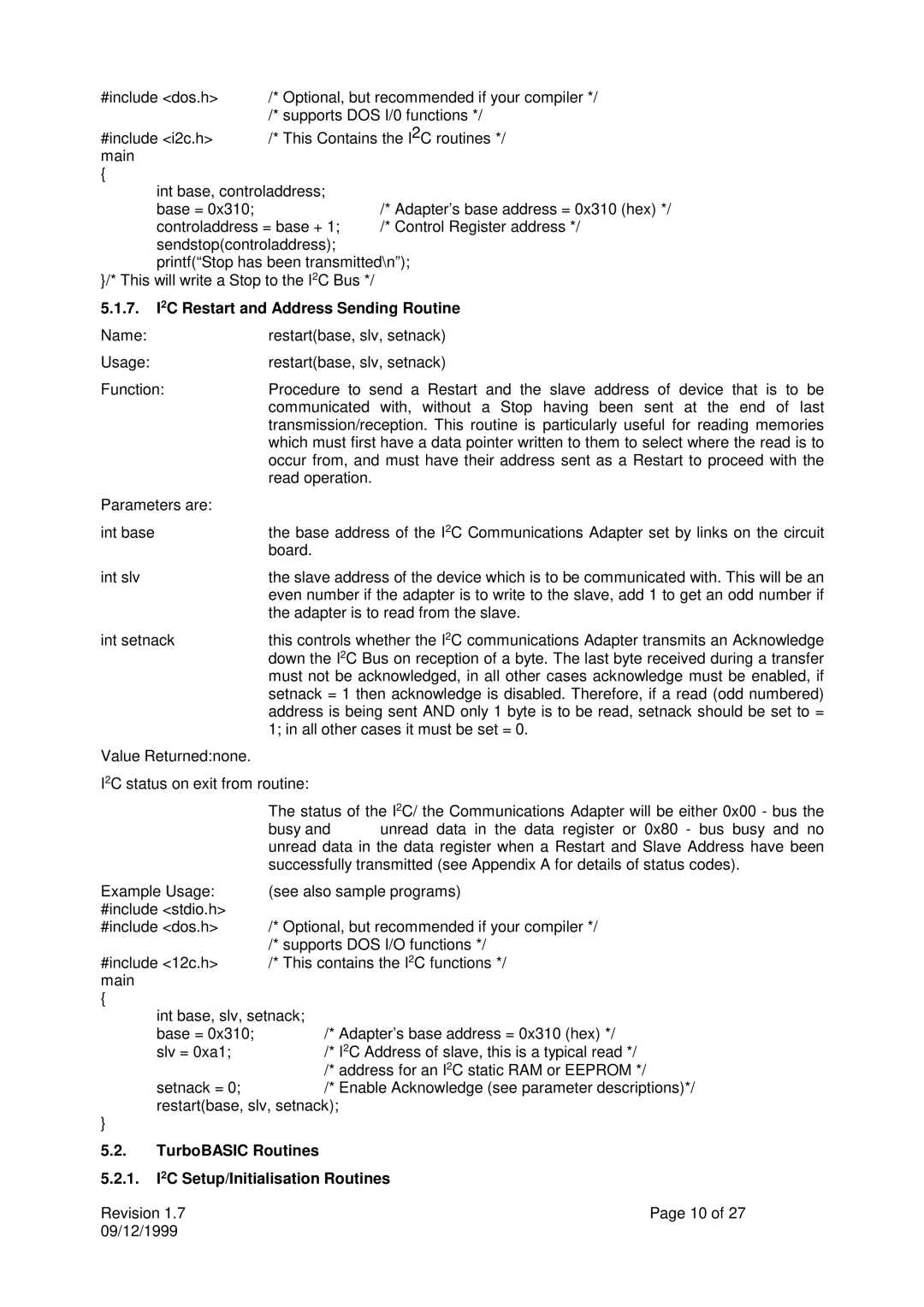#include <dos.h> | /* Optional, but recommended if your compiler */ | |
| /* supports DOS I/0 functions */ | |
#include <i2c.h> | /* This Contains the I2C routines */ | |
main |
|
|
{ |
|
|
int base, controladdress; |
| |
base = 0x310; |
| /* Adapter’s base address = 0x310 (hex) */ |
controladdress = base + 1; | /* Control Register address */ | |
sendstop(controladdress); |
| |
printf(“Stop has been transmitted\n”); }/* This will write a Stop to the I2C Bus */
5.1.7.I2C Restart and Address Sending Routine
Name: | restart(base, slv, setnack) |
Usage: | restart(base, slv, setnack) |
Function: | Procedure to send a Restart and the slave address of device that is to be |
| communicated with, without a Stop having been sent at the end of last |
| transmission/reception. This routine is particularly useful for reading memories |
| which must first have a data pointer written to them to select where the read is to |
| occur from, and must have their address sent as a Restart to proceed with the |
| read operation. |
Parameters are: |
|
int base | the base address of the I2C Communications Adapter set by links on the circuit |
| board. |
int slv | the slave address of the device which is to be communicated with. This will be an |
| even number if the adapter is to write to the slave, add 1 to get an odd number if |
| the adapter is to read from the slave. |
int setnack | this controls whether the I2C communications Adapter transmits an Acknowledge |
| down the I2C Bus on reception of a byte. The last byte received during a transfer |
| must not be acknowledged, in all other cases acknowledge must be enabled, if |
| setnack = 1 then acknowledge is disabled. Therefore, if a read (odd numbered) |
| address is being sent AND only 1 byte is to be read, setnack should be set to = |
| 1; in all other cases it must be set = 0. |
Value Returned:none. |
|
I2C status on exit from routine:
| The status of the I2C/ the Communications Adapter will be either 0x00 - bus the | |
| busy and | unread data in the data register or 0x80 - bus busy and no |
| unread data in the data register when a Restart and Slave Address have been | |
| successfully transmitted (see Appendix A for details of status codes). | |
Example Usage: | (see also sample programs) | |
#include <stdio.h> |
|
|
#include <dos.h> | /* Optional, but recommended if your compiler */ | |
| /* supports DOS I/O functions */ | |
#include <12c.h> | /* This contains the I2C functions */ | |
main |
|
|
{ |
|
|
/* Adapter’s base address = 0x310 (hex) */
/* I2C Address of slave, this is a typical read */ /* address for an I2C static RAM or EEPROM */
setnack = 0;/* Enable Acknowledge (see parameter descriptions)*/ restart(base, slv, setnack);
}
5.2.TurboBASIC Routines
5.2.1.I2C Setup/Initialisation Routines
Revision 1.7 | Page 10 of 27 |
09/12/1999 |
|
